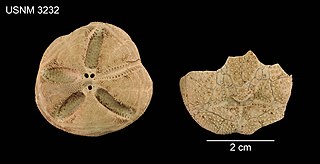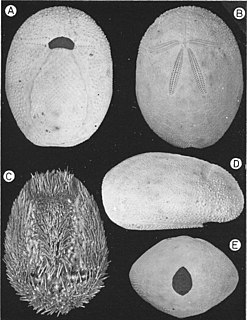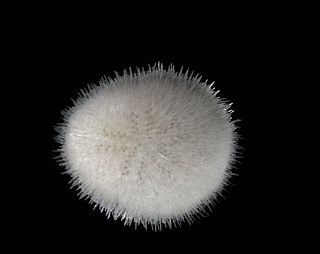
Sea urchins are spiny, globular echinoderms in the class Echinoidea. About 950 species of sea urchin live on the seabed of every ocean and inhabit every depth zone — from the intertidal seashore down to 5,000 meters. The spherical, hard shells (tests) of sea urchins are round and spiny, ranging in diameter from 3 to 10 cm. Sea urchins move slowly, crawling with tube feet, and also propel themselves with their spines. Although algae are the primary diet, sea urchins also eat slow-moving (sessile) animals. Predators that eat sea urchins include a wide variety of fish, starfish, crabs, marine mammals. Sea urchins are also used as food especially in Japan.

The Diadematidae are a family of sea urchins. Their tests are either rigid or flexible and their spines are long and hollow.

Diadema setosum is a species of long-spined sea urchin belonging to the family Diadematidae. It is a typical sea urchin, with extremely long, hollow spines that are mildly venomous. D. setosum differs from other Diadema with five, characteristic white dots that can be found on its body. The species can be found throughout the Indo-Pacific region, from Australia and Africa to Japan and the Red Sea. Despite being capable of causing painful stings when stepped upon, the urchin is only slightly venomous and does not pose a serious threat to humans.

Meoma ventricosa, known by the common names cake urchin and red heart urchin, is a large species of sea urchin which lives in shallow waters in the Caribbean. It may reach a diameter of twenty centimeters and is covered in reddish-brown spines. It has both pentagonal radial symmetry and bilateral symmetry, giving it a sand-dollar appearance; however, two of its five sections are merged more closely than the others.

Astropyga radiata, the red urchin, fire urchin, false fire urchin or blue-spotted urchin, is a species of sea urchin in the family Diadematidae. It is a large species with long spines and is found in the tropical Indo-Pacific region. It was first described in 1778 by the German naturalist Nathaniel Gottfried Leske.

Lytechinus variegatus, commonly called the green sea urchin or the variegated sea urchin, is a species of sea urchin that can be found in the warm waters of the western Atlantic Ocean and Caribbean Sea.

Abatus cordatus is a species of sea urchin in the family Schizasteridae. It is native to shallow seas surrounding certain island groups in the southern Indian Ocean. The body is protected by a hard test or shell which is covered with spines. The female broods its young in deep pockets on the upper surface, retaining the young in place with specialised spines. American zoologist Addison Emery Verrill first scientifically described A. cordatus in 1876.
Lytechinus williamsi, the jewel urchin, is a sea urchin in the family Toxopneustidae. It occurs on shallow reefs off the coasts of Panama, Belize, the Florida Keys and Jamaica.

Cidaris cidaris is a species of sea urchin commonly known as the long-spine slate pen sea urchin. It is found in deep water in the eastern Atlantic Ocean and the Mediterranean Sea.

Brissus agassizii is a species of sea urchins of the family Brissidae. Their armour is covered with spines. Brissus agassizii was first scientifically described in 1885 by Döderlein.

Brissus gigas, also known as the giant heart urchin, is a species of sea urchins of the family Brissidae. Their armour is covered with spines. Brissus gigas was first scientifically described in 1947 by H.B. Fell.

Brissus latecarinatus is a species of sea urchins of the family Brissidae. Their armour is covered with spines. Brissus latecarinatus was first scientifically described in 1778 by Nathanael Gottfried Leske.
Brissus meridionalis is a species of sea urchins of the family Brissidae. Their armour is covered with spines. Brissus meridionalis was first scientifically described in 1950 by Ole Theodor Jensen Mortensen.

Brissus obesus is a species of sea urchins of the family Brissidae. Their armour is covered with spines. Brissus obesus was first scientifically described in 1867 by Verrill.

Clypeaster australasiae, the Australasian sand dollar, is a species of sea urchins of the Family Clypeasteridae. Their armour is covered with spines. Clypeaster australasiae was first scientifically described in 1851 by Gray.

Diadema savignyi is a species of long-spined sea urchin belonging to the family Diadematidae. Common names include long-spined sea urchin, black longspine urchin and the banded diadem. It is native to the east coast of Africa, the Red Sea, the Indian Ocean and western Pacific Ocean. It was first described in 1829 by the French naturalist Jean Victoire Audouin. The specific epithet honours the French zoologist Marie Jules César Savigny who described many new marine species from the Mediterranean Sea and Red Sea. The type locality is Mauritius.

Clypeaster humilis is a species of sea urchin in the Family Clypeasteridae. This species was first scientifically described in 1778 by the German biologist Nathanael Gottfried Leske. It occurs in the tropical Indo-Pacific region.

Leodia sexiesperforata, commonly known as the six-holed keyhole urchin, is a species of sand dollar, in the echinoderm order Clypeasteroida. It is native to tropical and sub-tropical parts of the western Atlantic Ocean where it buries itself in soft sediment in shallow seas.

Parechinus angulosus, the Cape urchin, is a sea urchin in the family Parechinidae endemic to southern Africa.

Echinocyamus pusillus, commonly known as the pea urchin or green urchin, is a species of sand dollar, a sea urchin in the family Fibulariidae, native to the northeastern Atlantic Ocean and the Mediterranean Sea. It buries itself in gravel or coarse sand at depths down to about 1,250 m (4,000 ft).



















